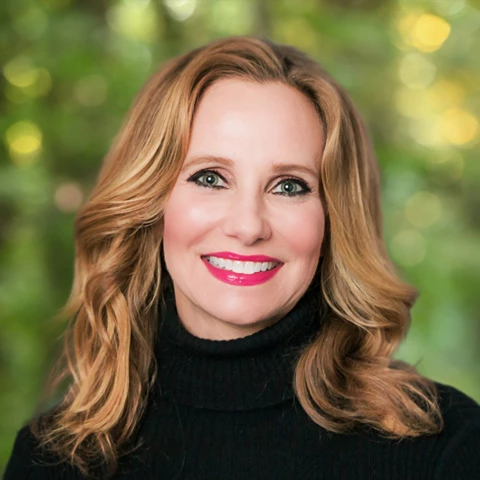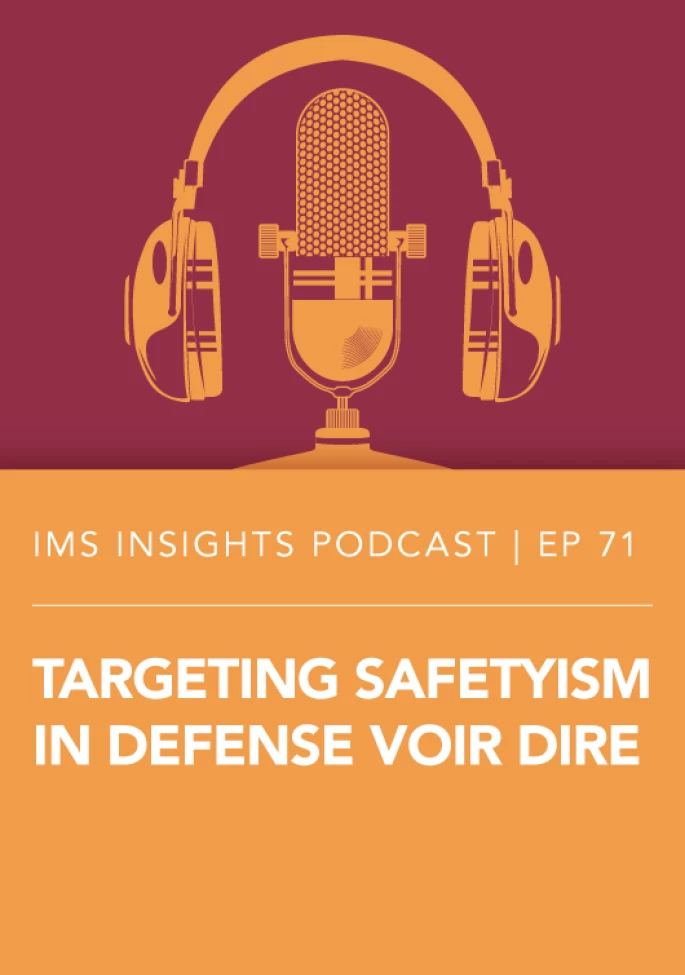IMS Senior Jury Consulting Advisors Chris Dominic and Jill Leibold, PhD explore the growing influence of safetyism in litigation—a cultural mindset that significantly shapes how jurors evaluate risk, assign responsibility, and determine damages. Dr. Leibold shares findings from her groundbreaking research, revealing how safetyism contributes to the rise of high-dollar nuclear verdicts. The discussion offers critical insights into how this mindset affects voir dire, jury selection, and case strategy.
04.30.25
|Chris Dominic: Welcome, everyone. I'm Chris Dominic, a Senior Strategy and Jury Consulting Advisor at IMS. We partner with trial lawyers to help them sharpen their litigation strategies and gain an edge in the courtroom.
Today, I'm excited to chat with my colleague, Dr. Jill Leibold, a veteran trial consultant and researcher whose work has shaped jury selection strategies and some of the most high-stakes cases in the nation. Jill has pioneered groundbreaking research on safetyism in litigation, a mindset that shapes how jurors perceive risk, responsibility, and damages. Her research uncovers how safetyism fuels the rise of high-dollar nuclear verdicts and offers critical insights into how it impacts voir dire jury selection and case themes. We're here to dive into the results of Jill's independent study, shedding light on the phenomenon. Jill, welcome. It's great to have you here.
Jill Leibold, PhD: Thank you.
Chris Dominic: So for those who are unaware, why don't we start with the definition, Jill? What's safetyism?
Jill Leibold, PhD: Sure. Safetyism is really a societal trend that has been slowly emerging over the past two or three decades but largely reared its head in litigation more recently, or we've noticed it more recently because we've been seeing nuclear verdicts and more plaintiff-oriented verdicts. And if you think about the rise of nonstop sensational media about disasters, safety mishaps, and also criminal activity, the 24/7 news cycle, and we're seeing those seeds planted maybe even as early as 1979 when Americans really started watching uninterrupted coverage of the Three Mile Island disaster. And that's where the 24/7 news cycle really started.
And because of that, and it continued, psychological literature has kept up with this trend. And we've really noticed the concept of risk has changed, too, over the course of each of those decades. And where it used to be a calculation of the benefits in comparison to potential harm, over time, that idea or the feeling of risk changed to a feeling, and how much that feeling one was willing to tolerate. And today risk is still a feeling, but one perceived increasingly as a threat where any risk might lead to harm and that it also includes not just physical risk, but emotional harm as well. And so both of those components have become a sensitivity point in our jurors and jury pool today.
Chris Dominic: Okay, so when you think about it from the jurors point of view, Jill, how does this elevated sense of risk influence the way they actually make decisions?
Jill Leibold, PhD: Well, there's a book called The Coddling of the American Mind by Greg Lukianoff and Jonathan Haidt. And in that book, now they are experts in the educational realm, so they were writing about the educational realm, but in that book, they described three thought fallacies that culminate in what they coined as safetyism. The people who are more prone to these thought fallacies tend to behave in three different ways, as the authors described in their theory.
So, safetyists tend to focus on the worst-case scenario and then perceive it as the most likely outcome, even when the realistic risk assessment may make it statistically highly unlikely. In their mind, things are much more common, bad things are much more common than they actually are in reality. And because of this mindset, they have a mentality of full risk avoidance. There is no room for accommodating reasonable or acceptable risk. And that doesn't just apply to when they think about products, but it also applies to verbal or written work, education, social encounters, and their emotional atmosphere there.
The second thought fallacy is that safetyists tend to put feelings first. They value their gut and their instinctual reactions above reasoned thought and evidence. Feelings are facts for safetyists. And finally, they really see the world in black and white, a battle between good and evil. And this tribalism really causes them to separate and divide from people who don't agree with them. And so safetyists, to them, it's, “If you're not with me, you're against me”. And we're seeing a lot less compromise and a lot less discourse among jurors when safetyism is in the room, in the deliberation room.
Chris Dominic: That was a fascinating book. You know, I've been wanting to ask you, are you seeing a correlation between age and safetyist beliefs? In other words, is this something that overlaps with generational profiles like Gen Z? And if so, how much should attorneys really lean on that in jury selection?
Jill Leibold, PhD: Oh, it absolutely does. Well, there's always exceptions. Gen Z has been raised in a culture of safetyism. They grew up with the structured play dates, unlike Gen X where, you know, we were running around our neighborhood after dark and jumping off our neighbor's roof playing hide and seek. That just would never happen with Gen Z. Their world has been so shaped by safety culture and in the way that our culture thinks about risk. And as a result, they're more risk adverse, and it's definitely something that defense attorneys need to consider.
The other thing that we're seeing is that social justice as a college major is a big field now, and we see that in voir dire. We're hearing from these same jurors, the younger jurors, that the concept of justice is really important to them, that it holds a very significant meaning to them, and that it's a mindset that really aligns with plaintiff-oriented views. So those generational categories are really important in assessing jurors during jury selection.
And one thing I've noticed is it's interesting, is millennials, and we used to talk about millennials all the time, and now it's Gen Z. But they were once seen as a challenge for the defense ,but what we're seeing now is that they've aged into more balanced jurors. They have life experience now, families, and careers, and all of those things have made them a little bit more pragmatic than they were in their younger years when they thought they knew everything and had experienced everything. And now they've actually created those experiences.
Chris Dominic: Yeah, that makes a lot of sense. Hey, I want to transition this over to when you're working with a client developing trial themes. Like I've noticed some attorneys think they can say something twice and it's too much, and others believe in repetition, but don't really read the room very well. and the juror eye rolls start. Where do you think the sweet spot is?
Jill Leibold, PhD: I'm a really strong advocate for weaving consistent themes throughout an entire case. Jurors have a ton of information that they need to process, and if it's a complex case, sometimes it'll feel to them like it's just through a fire hose. And the repetition really helps reinforce key messaging. And so the way that the theme is presented matters. With witnesses, for example, it's best to let them express the theme in their own words rather than sounding rehearsed. When I work with witnesses, I make sure they understand the overarching case themes, but we also tailor their testimony to focus on their specific puzzle piece of the case, and that way their testimony aligns with the broader strategy without sounding scripted.
One thing I wouldn't rely on is trying to establish a theme early or too early in voir dire. Many jurors, they're not really paying close attention at that stage. None of them expect to be selected, and I found in post-trial interviews that they don't often remember much from voir dire at all. And once they're seated and sworn in, they're fully engaged. And that's when reinforcing those themes becomes crucial. But up until the point where they're sworn in, they aren't going to remember a lot because none of them really think that they're still going to be there.
Chris Dominic: Okay, so does your data set suggest that jury selection strategies should shift depending on whether you're dealing with a rural group, an urban group, a suburban group? What do you say?
Jill Leibold, PhD: Yeah, yes, absolutely. One of the findings that we had our study was a national study. So we captured juror attitudes and experiences from all walks of life in America. And one of our key findings is that safetyism is a lot stronger in urban areas than it is in rural communities. So, when I'm in a city, I focus more on safety-driven mindsets, while in rural areas, other factors come into play. And that's not to say that safetyism isn’t still there, but we'll see less of it.
So for example, in more rural communities, emotional thinking, that emotional component of safetyism still plays a really big role, particularly when it comes for sympathy for the plaintiffs. But a different challenge emerges there, conspiracy thinking. And while conspiracies aren't part of safetyism, that was also part of our study, and we found that it's a whole separate bucket of pro-plaintiff thinking, we tend to see it more in rural communities and so they tend to be more receptive to conspiracy narratives. And that actually can be pretty dangerous for the defense because plaintiffs cases are often framed around, you know, perceived wrongdoing by a corporation or cover ups that also could include government agencies. And so if a jury already leans toward conspiracy thinking, they might be more inclined to buy into a plaintiff's argument without examining all the facts. So while safetyism as a whole is very dominant in urban areas, conspiracy thinking is really more of a concern in rural venues. But across the board, regardless of the type of case or the venue, emotional decision making is something that we always need to account for. And it's something, the emotional decision making component, is something that we even see in the driest of contracts case, for example, or a patent case. The emotional thinking really does drive that safetyist component comes in, comes through and drives the way that they perceive those cases, too.
Chris Dominic: Okay. I want to dig into that just a little more because in cases where you're working with the defense side of the case, and the defense relies heavily on jurors applying the law, say, determining the standard of care for a physician or proximate cause or something like that. You know, these jurors we see in our mock trials who respond to facts like they do by saying things like, well, yeah, but I just feel… right. How do you identify jurors who might look for ways to interpret the legal language in more plaintiff friendly ways when you're working for the defense?
Jill Leibold, PhD: That is a challenge because those jurors tend to be emotional thinkers who go with their gut instead of the facts. And so one way to counter this is by reinforcing that the law itself is a fact. For example, I always emphasize in jury selection that this is a court of law and not a court of feelings. And everyone's going to have feelings about what happened in a case, it's just human nature, but that the jurors have to base their decision on the legal standard and not on any gut feelings or emotions that they might have.
So a key strategy, if you do have some emotional thinkers on a jury, it's often not possible to get rid of them all, is to repeat the law throughout the trial. And if there's a specific jury instruction or like say a contract clause might be really important, you've got to keep it front and center for them so that they can't stray from it. In a recent contract case, for instance, I saw jurors completely disregard the first line of contract clause that specified when royalty payments were supposed to end, and they just skipped over it because it didn't fit their emotional narrative of what was fair. And it took repeated emphasis on that exact wording to get them to focus on what the contract actually said. And for defense attorneys, the goal is to make sure the jurors who do follow the law can anchor the deliberations and redirect the emotional thinkers back to the facts.
Chris Dominic: Jill, thank you so much. Before we go, I should let you know that your groundbreaking research has really helped me and our other colleagues. It illuminates how jurors' mindsets are evolving and what trial attorneys can do to adapt.
Thanks for joining us today, and thanks to everyone else for tuning in. If you want to dive deeper into safetyism or learn more about how IMS can give you or your case an edge, check out imslegal.com or shoot us an email at contactus@imslegal.com. See you next time, everybody.
IMS has served trusted law firms and corporations worldwide for more than 30 years in over 45,000 cases. As a strategic partner for the full case life cycle, our integrated teams provide specialized advisory support, expert witness services, litigation consulting, visual advocacy, and presentation technology to elevate strategies and protect hard-earned reputations. Learn more at imslegal.com.
Episode Guests:
-

Jill M. Leibold, PhD
Senior Jury Consulting Advisor
Episode Hosts:
-

Chris Dominic
Senior Jury Consulting Advisor
Related Industry Insights
-

11.13.24
Podcast |
Related Industry Insights
Targeting Safetyism in Defense Voir Dire | Episode 71
-

11.04.24
Article |
Related Industry Insights
A New Focus for Defense Voir Dire: Safetyism
-

10.09.23

IMS partners with the most influential global law firms and corporations to elevate their legal strategies. Our trusted expertise is hard-earned. Together, we win.







